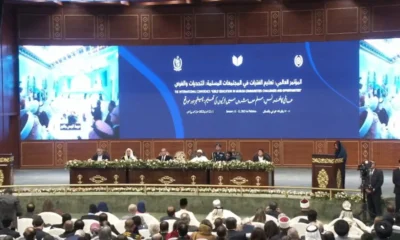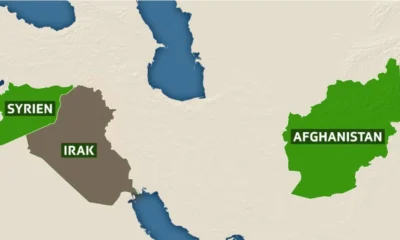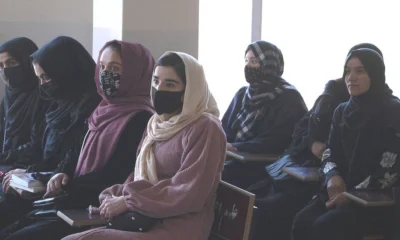Asia
Why the Taliban supreme leader is hiding

Since the return of the Taliban to power on 15 August 2021, its supreme leader did not appear in the public; rather occasionally made some audio tapes briefing unknown figures. Mullah Hibatullah, the leader of Taliban, has no video or picture. There is only one photo of him and its credibility is also under quotation. In the last two and half years that the Taliban seized power, Hibatullah has neither been photographed in public nor delivered a live video speech. The best he could do is to release audio messages as he did recently and spoke about the women’s rights situation.
In a speech at a gathering among other Taliban leaders in Kandahar province, he adopted an anti-western posture as well as claimed that the rights of women in Afghanistan have been fully preserved.
In his speech he said that he released a degree containing six principles to observe women’s rights including ban on marrying a woman by force, don’t violate Mahr, (money for the bride only), don’t marry a widow by force and give women their heritage.
“Our struggle against the western countries has not ended yet and we have to implement Islamic law which they oppose and against the Sharia hudud (an Islamic method of punishment of the offenders and criminals),” he added.
He said that if the Taliban implements hudud and stoned a woman in public or lashes people in public, these are in contrast with democracy and the west will stand against them. “We have to struggle and make efforts to implement hudud and we need to fight and struggle against the West and their un-Islamic demands,” he added.
This comes as nearly seven months ago, the Taliban supreme leader in another audio recording expressed desire to have good ties with the world, particularly with the Islamic countries. He also mentioned that the Taliban will never interfere into internal affairs of any neighboring countries and beyond.
Not a single word regarding women’s rights to work and education
But the most frustrating point is that the Taliban leader did not mention any statement regarding women’s rights to work and girls’ rights to education. People, especially the Afghan women are expecting to do something different from the Taliban leader, especially about their rights to work and education. However, such statements not only fail to alleviate the concern but it adds to these anxieties and worries.
Anisa Ahmadzai, an Afghan women’s rights activist countered Hibatullah statements and said that he doesn’t know the ground reality in Afghanistan where women and girls are deprived of their normal and basic rights which is education and work. “Sir, we, the Afghan women have been deprived of our basic rights that Allah the Almighty has given us. Education is obligatory for men and women, but under your (Hibatullah) rule, the Afghan women and girls were stopped from pursuing education,” she added.
She also said that the Taliban even banned girls above sixth grade from going to schools, and she called it “shameful and un-lamaic” practice.
Meanwhile, the Taliban also arrested dozens of girls and women from across Kabul city for alleged dress code violations or not observing the Taliban’s hijab requirement. It has been also reported that the Taliban tortured these female detainees and released them after getting guarantees from their family members.
Perennial question; Why Taliban supreme leader yet to reveal his face
The perennial question has always been why the Taliban supreme leader has yet to reveal his face to the people and what logical reason could be behind this action. This is important for the Taliban leader to engage in face-to-face engagement with the people in order to earn their trust and confidence. Right now, many people even doubt if there is any supreme leader, despite him having spoken in recent audio tapes.
The Afghans have all the right to think like that because the supreme leader and founder of the Taliban, Mullah Omar had released Eid messages for two years but later found out that two years ago he died in one of hospitals in Pakistan. So, who released these statements, and why the Taliban hid his dead among the people. So, the same applies for the current Taliban leader: there could be no existence, but someone is just releasing audio speeches relating to the supreme leader.
Another issue that the supreme leader doesn’t want to show to the public is called insecurity, according to his spokesman, but the Taliban has already claimed that security has been improved. The Taliban must stop taking credit for the security situation while their supreme leader can’t appear in public due to security issues.
Asia
Pakistan boosts defense spending by 17% amid tensions with India
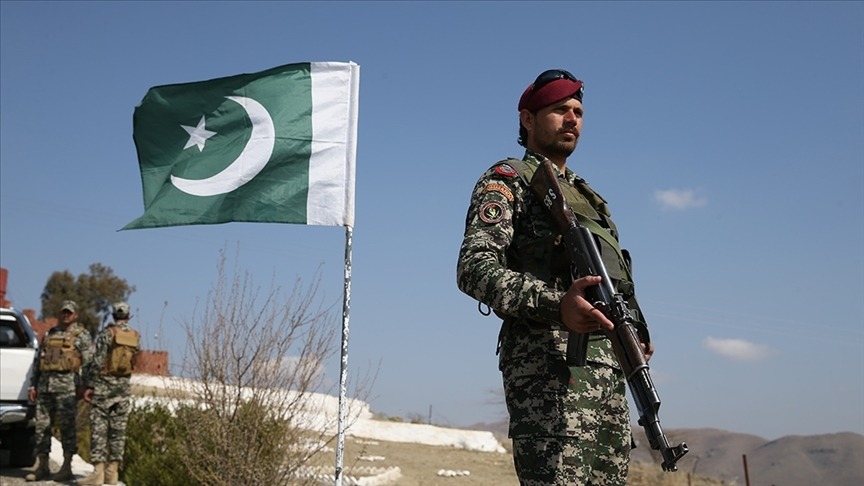
Pakistan has significantly increased its defense spending in its latest budget, citing growing security demands following recent military tensions with India. In contrast, development spending has been curtailed to meet the fiscal discipline conditions set by the International Monetary Fund (IMF).
On Tuesday, Pakistan announced its budget for the 2026 fiscal year, which begins on July 1. The total expenditure is set at $62 billion, with $29 billion allocated for debt financing. The most notable development in the budget is the allocation of $9 billion for defense spending, an increase of approximately 17% from the previous year.
This move comes as Pakistan reassesses its military preparedness following recent conflicts with India. In the four-day conflict that began on May 7, 51 people were killed on the Pakistani side, while at least 16 lost their lives on the Indian side.
Experts have noted that the increase in defense spending was inevitable.
“In Pakistan, the most serious conflict with India in several decades will certainly create an incentive to increase defense spending,” South Asia analyst Michael Kugelman told Nikkei Asia. “The public’s support for efforts against India gives civilian and military leaders the political space to take these steps,” he added.
Some believe the government should allocate even more to defense. One group advocating for this is Tola Associates, a tax advisory and consulting firm. In a recently published budget report, the company stated that defense spending should be increased by 32%. “Due to the state of war with the neighboring country and the recruitment of new army personnel, it is recommended that the defense budget for the 2026 fiscal year be increased to $10 billion,” the report noted.
Other experts argue that the issue is not just about how much the total defense budget will increase. “India’s defense spending remains nearly nine times that of Pakistan,” Syed Muhammad Ali, an Islamabad-based security analyst, told Nikkei. “This large gap indicates that Islamabad wants to deter India credibly and cost-effectively without engaging in a costly arms race in the region.”
Other officials and experts told Nikkei that Pakistan will focus on strengthening its air defense capabilities among its three armed forces.
“Pakistan will purchase HQ-19 missiles from China to strengthen its air defense against future Indian attacks,” a government official, speaking to Nikkei on the condition of anonymity, said. The HQ-19 is a Chinese-made surface-to-air missile system designed to counter medium-range ballistic missiles.
Kugelman said that Pakistan will make decisions on defense spending to strengthen weak areas revealed in the recent conflict, with such air defense systems at the top of the list. “India was able to deploy missiles and drones deep into Pakistani territory, and it did so quite intensively. This is a key area where we can expect some of the funding increase to be directed,” he added.
Ali also believes that air defense and related areas will be a priority. “Contrary to traditional land-air-sea warfare concepts, the role of air and space power, such as beyond-visual-range air combat, electronic warfare, drone warfare, missile warfare, and cyber warfare, is increasingly growing,” he said.
However, Pakistan’s budget is also under strict scrutiny from the IMF, which signed a $7 billion loan agreement with Islamabad last September.
“As Pakistan remains in the 37-month IMF program until 2027, the Fund plays a central role in shaping the budget,” Naafey Sardar, an assistant professor of economics at St. Olaf College in the US, told Nikkei. “Without the IMF’s approval, Pakistan cannot receive the financing tied to the program or support from other multilateral lending institutions,” he added.
“The IMF will push for stricter compliance and a broader tax base. This increases the likelihood of new tax hikes in certain sectors and limited relief for the salaried class,” he stated.
The IMF’s demand for strict budget implementation has led Pakistan to cut its development spending.
In the upcoming budget, Pakistan has allocated $3.5 billion for development expenditures, a sharp decrease of $1.4 billion from the previous budget.
“This cut will further hinder and potentially slow down significant social and infrastructure projects, especially since development spending has repeatedly been the target of budget cuts in recent years to meet IMF program objectives,” Sardar told Nikkei.
“In such a scenario, when the defense budget increases, the [development] budget allocated for health and education decreases,” said Tahir Naeem Malik, a professor at the National University of Modern Languages in Islamabad.
“With a population of 250 million, Pakistan has great needs in these sectors. This creates a contradiction: should the focus be on human development or on defense?” Malik asked.
Asia
Huawei founder claims chips are a generation behind the US
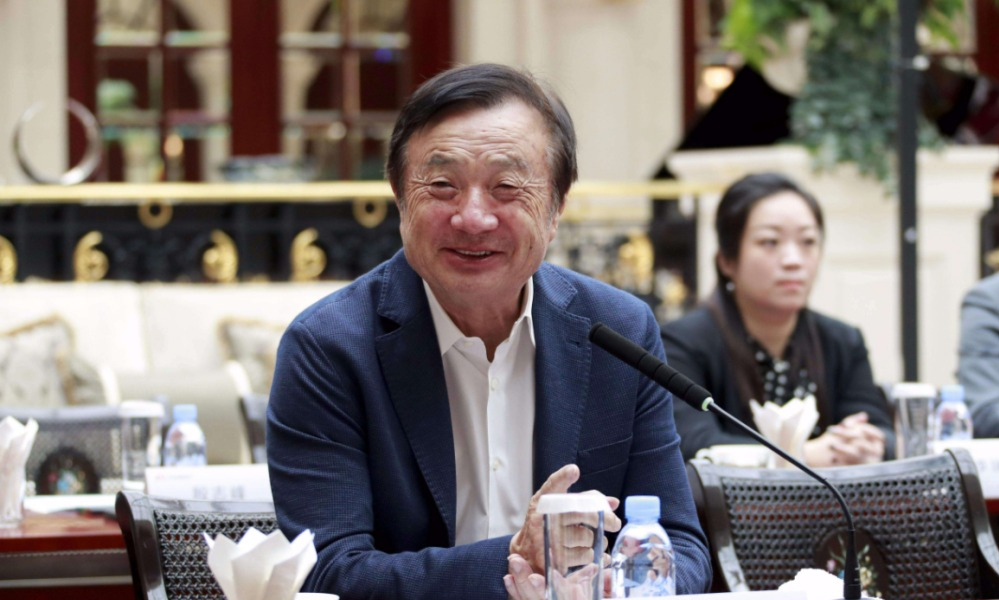
The founder of Huawei has stated that the United States is overestimating the capabilities of the Chinese chip manufacturer, even as trade negotiations, including export controls, continue between Beijing and Washington.
In a rare interview with China’s state-run newspaper People’s Daily on Tuesday, Ren Zhengfei said that Huawei’s Ascend chip, the main domestic rival to Nvidia’s products in China, is “still one generation behind the US.” He added, “The US is overestimating Huawei’s capabilities; we are not that strong yet.”
Ren’s comments follow recent warnings from Nvidia CEO Jensen Huang about Huawei’s advancements in artificial intelligence (AI) chips. Huang argued that Washington’s restrictions on the US chipmaker’s sales to China have inadvertently created a “formidable” competitor, threatening America’s dominance in AI technology.
The US and China began a new round of trade negotiations in London on Monday, with Washington’s export controls on key technologies on the agenda.
During the initial round of talks in Geneva, the US did not bring up export controls. However, Beijing’s recent restrictions on certain critical rare earth elements and minerals used in automobile manufacturing, which threaten to shut down factory lines in the US, Europe, and Japan, have pushed the issue to the forefront of trade discussions.
Huawei has benefited from Washington’s ban on Nvidia chip shipments to China, as Chinese tech giants have accelerated their purchases of Ascend chips and made preparations to adopt Huawei’s technology.
Still, most Chinese AI companies, including DeepSeek, rely on Nvidia chips to train the large language models (LLMs) that power their AI tools. For less complex tasks, such as inferencing models to generate responses in tools like chatbots, domestic alternatives are increasingly being used.
Analysts and Huawei researchers have previously noted technical difficulties when using the company’s chips to train LLMs, citing challenges in getting the chips to work together and distribute the computational workload effectively.
On Tuesday, Ren implied that the company has made significant strides in resolving these issues, stating that Huawei can “compensate” for lower performance through cluster computing, which links multiple chips to boost AI server power.
“By using clustering and stacking, our computing results are comparable to the best in the world,” he said.
Ren mentioned that Huawei invests 180 billion yuan ($25 billion) annually in research and development, with 60 billion yuan dedicated not to product development but to basic research aimed at groundbreaking discoveries.
He also noted that China possesses distinct advantages in developing its technological capacity.
“Artificial intelligence depends on abundant electricity and an advanced network infrastructure,” he explained. “China’s power generation and grid systems are world-class. Our telecommunications infrastructure is one of the most advanced in the world.”
Asia
Japan, US showcase B-52 bombers in nuclear deterrence dialogue

Japan and the US held an “Extended Deterrence Dialogue” at Barksdale Air Force Base in Louisiana on June 5-6.
In an annual display of nuclear strength, US government officials showed their Japanese counterparts a fleet of B-52 strategic bombers at the Louisiana air base.
The first Extended Deterrence Dialogue of a potential second Trump administration took place last Thursday and Friday at Barksdale Air Force Base, the headquarters of the Air Force Global Strike Command. Photos from the visit were released on Monday.
The Global Strike Command in Louisiana oversees all of the Air Force’s bomber forces, including the B-52, B-1, and B-2 wings. The strategic bomber is the most flexible leg of the nuclear triad and the most visible deterrent when deployed near adversaries.
Since 2022, the allies have been holding dialogue meetings at key sites of America’s sea, air, and land-based nuclear triad to demonstrate the US nuclear umbrella against countries they have declared adversaries, such as China, Russia, and North Korea.
The continuation of this tradition, potentially into a second Trump term, reassures the Japanese side that the importance of extended deterrence remains unchanged.
These visits to strategic locations began in June 2022 with an inspection of the Ohio-class ballistic missile submarine (SSBN) USS Maryland at Kings Bay Naval Submarine Base in Georgia.
The following year, the Japanese delegation closely examined a B-2 stealth bomber at Whiteman Air Force Base in Missouri.
Last year, the Japanese observed several intercontinental ballistic missiles at Francis E. Warren Air Force Base in Wyoming, where they learned about the special procedures before a nuclear missile launch.
A press release from Japan’s Ministry of Foreign Affairs on Monday consisted of a single sentence: “Japan and the US held an Extended Deterrence Dialogue at Barksdale Air Force Base in Louisiana on June 5-6, 2024.”
The talks were established as a formal dialogue mechanism between the two governments in 2010 and are held regularly. The stated goal is to build a mutual understanding of deterrence, including nuclear capabilities.
During the dialogue, the two sides typically discuss the regional security environment and exchange views on the alliance’s defense posture, nuclear and missile defense policy, arms control, and risk reduction.
The talks included officials from Japan’s Ministry of Foreign Affairs and Ministry of Defense, as well as members of the Self-Defense Forces and the Embassy of Japan in Washington. The US side was represented by officials from the Department of State, the Pentagon, and the military.
-

 Middle East1 week ago
Middle East1 week agoLindsey Graham issues threat to Greta Thunberg and Gaza Freedom Flotilla
-

 Europe2 weeks ago
Europe2 weeks ago‘National-conservative’ CPAC convenes in Budapest
-

 Russia2 weeks ago
Russia2 weeks agoIOC confirms Russia’s exclusion from Italy 2026 Winter Games
-

 Interview2 weeks ago
Interview2 weeks ago‘Freedom of thought in the US has never been under greater threat’
-

 Europe2 weeks ago
Europe2 weeks agoOfficial EU language status for Catalan, Basque, and Galician delayed once more
-

 America2 weeks ago
America2 weeks agoUS mulls mandatory social media checks for all foreign student visa applicants
-

 Asia2 weeks ago
Asia2 weeks agoTrump administration reportedly orders US chip software firms to halt China sales
-

 Russia1 week ago
Russia1 week agoUkraine attacks Russian strategic bomber bases with truck-launched UAVs




